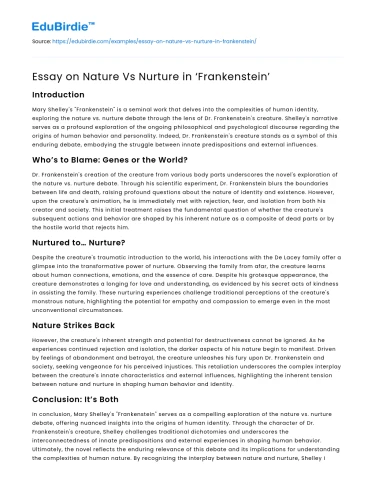Introduction
Mary Shelley's "Frankenstein" is a seminal work that delves into the complexities of human identity, exploring the nature vs. nurture debate through the lens of Dr. Frankenstein's creature. Shelley's narrative serves as a profound exploration of the ongoing philosophical and psychological discourse regarding the origins of human behavior and personality. Indeed, Dr. Frankenstein's creature stands as a symbol of this enduring debate, embodying the struggle between innate predispositions and external influences.
Who’s to Blame: Genes or the World?
Dr. Frankenstein's creation of the creature from various body parts underscores the novel's exploration of the nature vs. nurture debate. Through his scientific experiment, Dr. Frankenstein blurs the boundaries between life and death, raising profound questions about the nature of identity and existence. However, upon the creature's animation, he is immediately met with rejection, fear, and isolation from both his creator and society. This initial treatment raises the fundamental question of whether the creature's subsequent actions and behavior are shaped by his inherent nature as a composite of dead parts or by the hostile world that rejects him.
Save your time!
We can take care of your essay
- Proper editing and formatting
- Free revision, title page, and bibliography
- Flexible prices and money-back guarantee
Nurtured to… Nurture?
Despite the creature's traumatic introduction to the world, his interactions with the De Lacey family offer a glimpse into the transformative power of nurture. Observing the family from afar, the creature learns about human connections, emotions, and the essence of care. Despite his grotesque appearance, the creature demonstrates a longing for love and understanding, as evidenced by his secret acts of kindness in assisting the family. These nurturing experiences challenge traditional perceptions of the creature's monstrous nature, highlighting the potential for empathy and compassion to emerge even in the most unconventional circumstances.
Nature Strikes Back
However, the creature's inherent strength and potential for destructiveness cannot be ignored. As he experiences continued rejection and isolation, the darker aspects of his nature begin to manifest. Driven by feelings of abandonment and betrayal, the creature unleashes his fury upon Dr. Frankenstein and society, seeking vengeance for his perceived injustices. This retaliation underscores the complex interplay between the creature's innate characteristics and external influences, highlighting the inherent tension between nature and nurture in shaping human behavior and identity.
Conclusion: It’s Both
In conclusion, Mary Shelley's "Frankenstein" serves as a compelling exploration of the nature vs. nurture debate, offering nuanced insights into the origins of human identity. Through the character of Dr. Frankenstein's creature, Shelley challenges traditional dichotomies and underscores the interconnectedness of innate predispositions and external experiences in shaping human behavior. Ultimately, the novel reflects the enduring relevance of this debate and its implications for understanding the complexities of human nature. By recognizing the interplay between nature and nurture, Shelley invites readers to ponder the intricate dynamics of identity formation and the enduring quest for understanding the essence of humanity.






 Stuck on your essay?
Stuck on your essay?

